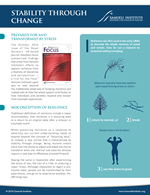Optimizing Human Performance
At the heart of a strong military and the success of our nation's defense is the resilience of its individuals and groups.

|
Samueli Institute looks beyond the traditionally siloed way of studying resilience and instead explores how the whole system contributes to how individuals and societies respond and recover from traumatic experiences.
which describes common misconceptions of resilience and five traits included in our understanding of resilience thinking.
|
The Service member is the most valuable asset the military has for accomplishing its mission of defending the country. Human health and performance optimization/enhancement (HPO/E) is the cornerstone of an effective and efficient military. Extensive resources are expended on assuring that equipment and materials are state of the art and in good repair; however, resources invested in determining how to maintain and improve human performance and health are more limited. A number of Department of Defense directives have addressed the need for a focused and coordinated HPO/E effort.
Samueli Institute's 2012 needs assessment showed that resilience competency and resilience-building efforts for soldiers and families must be the responsibility of every leader, and fully integrated into all aspects of military and family life throughout all military professional and deployment life cycles.
We study different aspects of resilience including models of human performance and reintegration into post-deployment life; exploring how nutrition plays a role in brain function and performance; evaluating how resiliency training programs help warfighters' performance under stress; and training the next generation of military medical professionals to cope with the stress of their jobs and the needs of their patients. Learn more about the following projects:
|
This work is supported by the US Army Medical Research and Materiel Command under Award Numbers:
W81XWH-08-2-0212; W81XWH-11-2-0173; W81XWH-08-1-0408; W81XWH-11-1-0759; W81XWH-10-1-0820; W81XWH-07-2-0076; W81XWH-06-1-0279; W81XWH-06-2-0009; W81XWH-10-1-1011; W81XWH-10-2-0184; W81XWH-08-1-0615; W81XWH-10-1-0938; W81XWH-11-1-0538
The views, opinions and/or findings contained in this report are those of the author(s) and should not be construed as an official Department of the Army position, policy or decision unless so designated by other documentation.
In the conduct of research where humans are the subjects, the investigator(s) adhered to the policies regarding the protection of human subjects as prescribed by Code of Federal Regulations (CFR) Title 45, Volume 1, Part 46; Title 32, Chapter 1, Part 219; and Title 21, Chapter 1, Part 50 (Protection of Human Subjects).
|